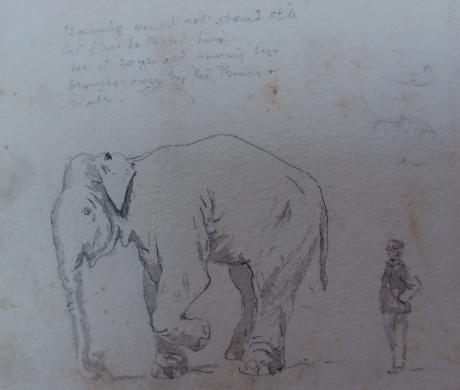extensively inscribed
During his tour of India in 1875-6, the Prince of Wales , Later King Edward VII was given a number of animals, including two young elephants. One of the elephants was mentioned in Dr. Fayrer's account of the tour: 'a female, aged seven, presented by Digbijeh Singh, at Lucknow' (p.136). He subsequently wrote: 'each elephant has a mahout, so that the best provision is made for their care!' (p.137).
It was quite usual for animals to be given to members of the Royal Family during foreign tours. The more exotic species, if they survived the journey home, were generally presented to the London Zoo but the smaller creatures, particularly dogs or birds, were often given a comfortable home with other household pets.
The Most famous Elephant at London Zoo was Jumbo .After arriving at London Zoo in 1865, Jumbo the Elephant became one of the star attractions.
Despite a popular appeal to keep him there, Jumbo was sold to the entertainer PT Barnum, who took Jumbo to America as part of his circus. Jumbo died in an accident in 1885, but his skeleton and stuffed skin continued to be used as part of Barnum’s show – and returned to London in 1890.
Jumbo was born in Sudan, in east Africa. After his mother was killed by poachers, he was imported to Europe and moved into London Zoo in 1865.
He wasn’t in a good state when he arrived. “A more deplorable, diseased and rotten creature never walked God’s earth,” wrote Matthew Scott, a zookeeper, who helped nurse Jumbo back to health.
Jumbo was an African bush elephant, one of the largest ever seen in Europe. While at the zoo, Jumbo weighed over 6 tonnes and was about 3.2 metres tall at the shoulder.
One of the zookeepers, Anoshan Anathjeysari, named him Jumbe, the Swahili word for chief. This is where we get the English word jumbo – meaning something extremely large.
Elephants had been seen in London before, but Jumbo became a favourite of Londoners. The zoo allowed children, including Queen Victoria’s, to ride on Jumbo’s back using a large saddle with several seats.
In 1882, London Zoo sold Jumbo to the American entertainer and showman Phineas T Barnum. Barnum wanted to display Jumbo in his circus, known as the Greatest Show on Earth.
While at the zoo, Jumbo had been showing signs of anger and unhappiness during the night. For example, he had ground down his tusks on the sides of his enclosure.
This behaviour was due to toothache – partly caused by visitors feeding him sugary treats.
The managers of the zoo worried that he would hurt someone. But the decision to sell Jumbo caused a public outcry. Newspapers and members of the public petitioned Barnum, asking him to let Jumbo stay in London.
Barnum refused, happy that his elephant was receiving so much publicity. Barnum toured America with Jumbo, advertising him as the world's largest elephant.
Lionel Grimston Fawkes, grandson of Walter Ramsden Hawkesworth Fawkes (an MP and patron of Turner), began his military training at the Royal Military Academy, Woolwich, he became professor of military topography there... By 1883 he was Dominic Gamble’s aide-de-camp in Jamaica. In 1885 he entered Staff College, Sandhurst. He became a Colonel in the Royal Artillery and later a Justice of the Peace. In 1891 he married Lady Constance Eleanor Kennedy, daughter of a Scottish peer. He was Professor of Military Topography at the Royal Military Academy from 1895 to 1900. By 1923 he and his wife had moved to Canada, purchasing the Point Comfort Hotel on Mayne Island and changing its name to Culzean after Constance’s ancestral home, Culzean Castle. They remained at Culzean for the rest of their lives.
Colonel Fawkes was a very accomplished artist and illustrator. His water-colours are held in collections around the world. Their married daughter, Lois died in 1919 leaving a one year old son Lawrence. Tragedy struck the Fawkes family again in 1921, when their other daughter, Monica, also died. This was all too much for the Colonel and Lady Constance and in 1924 they emigrated to Mayne Island, British Columbia with their son-in-law and grandson.

